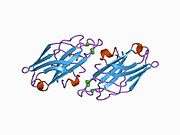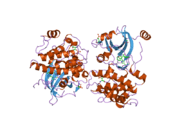PRKCB1
| View/Edit Human | View/Edit Mouse |
Protein kinase C beta type is an enzyme that in humans is encoded by the PRKCB gene.[5]
Protein kinase C (PKC) is a family of serine- and threonine-specific protein kinases that can be activated by calcium and second messenger diacylglycerol. PKC family members phosphorylate a wide variety of protein targets and are known to be involved in diverse cellular signaling pathways. PKC family members also serve as major receptors for phorbol esters, a class of tumor promoters. Each member of the PKC family has a specific expression profile and is believed to play a distinct role in cells. The protein encoded by this gene is one of the PKC family members. This protein kinase has been reported to be involved in many different cellular functions, such as B cell activation, apoptosis induction, endothelial cell proliferation, and intestinal sugar absorption. Studies in mice also suggest that this kinase may also regulate neuronal functions and correlate fear-induced conflict behavior after stress. Alternatively spliced transcript variants encoding distinct isoforms have been reported.[6] This gene could be associated with autism.[7] [8]
Interactions
PRKCB1 has been shown to interact with RIPK4,[9] Beta adrenergic receptor kinase,[10] PDLIM5[11] and GNB2L1.[12]
References
- ↑ "Diseases that are genetically associated with PRKCB view/edit references on wikidata".
- ↑ "Drugs that physically interact with Protein kinase C beta type view/edit references on wikidata".
- ↑ "Human PubMed Reference:".
- ↑ "Mouse PubMed Reference:".
- ↑ Kubo K, Ohno S, Suzuki K (November 1987). "Nucleotide sequence of the 3' portion of a human gene for protein kinase C beta I/beta II". Nucleic Acids Res. 15 (17): 7179–80. doi:10.1093/nar/15.17.7179. PMC 306204
 . PMID 3658678.
. PMID 3658678. - ↑ "Entrez Gene: PRKCB1 protein kinase C, beta 1".
- ↑ Philippi, A; Roschmann, E; Tores, F; Lindenbaum, P; Benajou, A; Germain-Leclerc, L; Marcaillou, C; Fontaine, K; et al. (October 2005). "Haplotypes in the gene encoding protein kinase c-beta (PRKCB1) on chromosome 16 are associated with autism". Mol. Psychiatry. 10 (10): 950–60. doi:10.1038/sj.mp.4001704. PMID 16027742.
- ↑ Lintas C; Sacco R; Garbett K; Mirnics K; Militerni R; Bravaccio C; Curatolo P; Manzi B; Schneider C; Melmed R; Elia M; Pascucci T; S Puglisi-Allegra; K-L Reichelt; Persico AM (2009). "Involvement of the PRKCB1 gene in autistic disorder: significant genetic association and reduced neocortical gene expression". Mol Psychiatry. 14 (7): 705–718. doi:10.1038/mp.2008.21. PMID 18317465.
- ↑ Chen, L; Haider K; Ponda M; Cariappa A; Rowitch D; Pillai S (June 2001). "Protein kinase C-associated kinase (PKK), a novel membrane-associated, ankyrin repeat-containing protein kinase". J. Biol. Chem. 276 (24): 21737–44. doi:10.1074/jbc.M008069200. PMID 11278382.
- ↑ Yang, Xing-Long; Zhang Ya-Li; Lai Zhuo-Sheng; Xing Fei-Yue; Liu Yu-Hu (April 2003). "Pleckstrin homology domain of G protein-coupled receptor kinase-2 binds to PKC and affects the activity of PKC kinase". World J. Gastroenterol. 9 (4): 800–3. PMID 12679936.
- ↑ Kuroda, S; Tokunaga C; Kiyohara Y; Higuchi O; Konishi H; Mizuno K; Gill G N; Kikkawa U (December 1996). "Protein-protein interaction of zinc finger LIM domains with protein kinase C". J. Biol. Chem. 271 (49): 31029–32. doi:10.1074/jbc.271.49.31029. PMID 8940095.
- ↑ Ron, D; Jiang Z; Yao L; Vagts A; Diamond I; Gordon A (September 1999). "Coordinated movement of RACK1 with activated betaIIPKC". J. Biol. Chem. 274 (38): 27039–46. doi:10.1074/jbc.274.38.27039. PMID 10480917.
Further reading
- Mochly-Rosen D (1995). "Localization of protein kinases by anchoring proteins: a theme in signal transduction". Science. 268 (5208): 247–51. doi:10.1126/science.7716516. PMID 7716516.
- Ali A, Hoeflich KP, Woodgett JR (2002). "Glycogen synthase kinase-3: properties, functions, and regulation". Chem. Rev. 101 (8): 2527–40. doi:10.1021/cr000110o. PMID 11749387.
- Slater SJ, Ho C, Stubbs CD (2003). "The use of fluorescent phorbol esters in studies of protein kinase C-membrane interactions". Chem. Phys. Lipids. 116 (1–2): 75–91. doi:10.1016/S0009-3084(02)00021-X. PMID 12093536.


